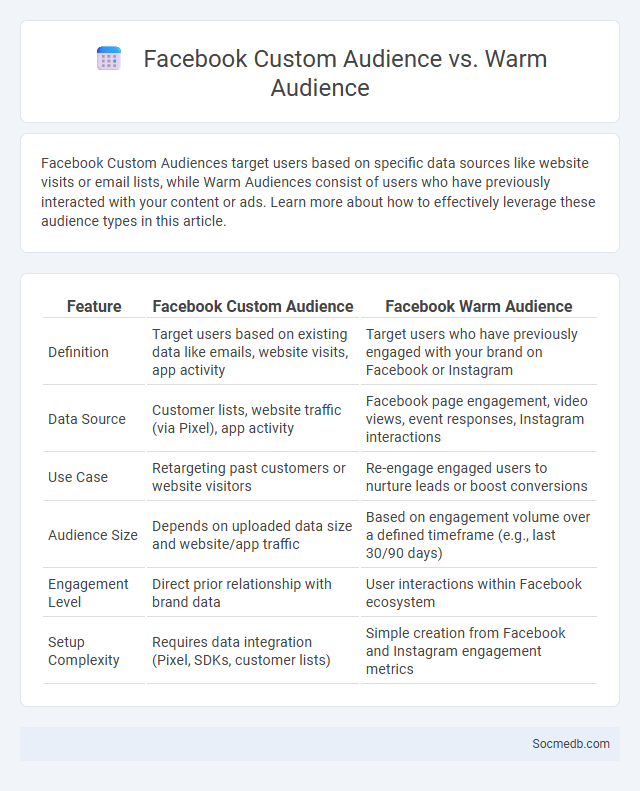
Photo illustration: Facebook Custom Audience vs Warm Audience
Facebook Custom Audiences target users based on specific data sources like website visits or email lists, while Warm Audiences consist of users who have previously interacted with your content or ads. Learn more about how to effectively leverage these audience types in this article.
Table of Comparison
| Feature | Facebook Custom Audience | Facebook Warm Audience |
|---|---|---|
| Definition | Target users based on existing data like emails, website visits, app activity | Target users who have previously engaged with your brand on Facebook or Instagram |
| Data Source | Customer lists, website traffic (via Pixel), app activity | Facebook page engagement, video views, event responses, Instagram interactions |
| Use Case | Retargeting past customers or website visitors | Re-engage engaged users to nurture leads or boost conversions |
| Audience Size | Depends on uploaded data size and website/app traffic | Based on engagement volume over a defined timeframe (e.g., last 30/90 days) |
| Engagement Level | Direct prior relationship with brand data | User interactions within Facebook ecosystem |
| Setup Complexity | Requires data integration (Pixel, SDKs, customer lists) | Simple creation from Facebook and Instagram engagement metrics |
Understanding Facebook Custom Audience
Facebook Custom Audience allows you to target specific groups of users based on your existing customer data, such as email lists, website visitors, or app users. By leveraging this feature, your advertising campaigns become highly personalized and efficient, increasing conversion rates and ROI. Implementing Custom Audiences helps you reach people already familiar with your brand, enhancing engagement and driving better sales outcomes.
What Is a Warm Audience on Facebook?
A warm audience on Facebook consists of users who have already interacted with your brand through actions such as visiting your website, engaging with your posts, or subscribing to your content. This audience demonstrates higher intent and familiarity, making them more likely to convert compared to cold audiences with no prior contact. Targeting warm audiences with Facebook Ads improves ad relevance, engagement rates, and return on ad spend by leveraging existing customer interest and trust.
Custom Audience: The Basics and Benefits
Custom Audience in social media advertising allows you to target specific groups of users based on their interactions with your brand, such as website visits or email lists, enhancing ad relevance and engagement. By leveraging data from your existing customers, you can create highly personalized campaigns that increase conversion rates and reduce advertising costs. Using Custom Audiences, your marketing efforts become more effective, turning potential leads into loyal customers through precise targeting.
Key Differences: Custom Audience vs Warm Audience
Custom Audience targets users based on specific data like email lists, website visits, or app activity, enabling precise retargeting and personalized ads. Warm Audience comprises users who've already engaged with your brand, such as previous customers or social media followers, making them more likely to convert. While Custom Audience relies on external data sources to build tailored groups, Warm Audience leverages existing brand interaction history for enhanced relevance and engagement.
How Facebook Custom Audiences Work
Facebook Custom Audiences work by allowing advertisers to upload a list of customer data, such as email addresses or phone numbers, which Facebook then matches with user profiles to create a targeted audience for ads. This process leverages hashed data to protect user privacy while enabling precise ad delivery based on real-world customer information. You can use Custom Audiences to retarget existing customers, increase conversions, and optimize your marketing campaigns effectively.
Advantages of Targeting Warm Audiences
Targeting warm audiences on social media enhances your marketing efficiency by focusing on users already familiar with your brand, increasing the likelihood of conversion. These audiences show higher engagement rates and responsiveness due to prior interaction, reducing advertising costs and improving return on investment. By leveraging warm leads, you optimize your social media campaigns to nurture existing interest and drive consistent sales growth.
Strategies for Building Effective Custom Audiences
To build effective custom audiences on social media, start by leveraging your existing customer data such as email lists, website visitors, and engagement metrics to create highly targeted segments. Use precise criteria like user behavior, interests, and demographics to refine audience relevance and improve ad performance. Your continuous testing and updating of these audiences will enhance personalization and maximize return on ad spend.
Best Practices for Engaging Warm Audiences
Engaging warm audiences on social media requires personalized content that resonates with their previous interactions and demonstrated interests. Utilizing retargeting strategies and dynamic ads increases relevance, while consistent communication through stories and live sessions fosters stronger connections. Measuring engagement metrics such as click-through rates and time spent on posts helps refine approaches for maximum impact.
Custom Audience Overlap: Avoiding Redundancy
Custom Audience Overlap in social media advertising occurs when multiple ad sets target the same users, leading to redundant impressions and inflated costs. Reducing overlap improves campaign efficiency by ensuring distinct audience segments receive tailored content without competition between ad sets. Utilizing Facebook's Audience Overlap Tool helps identify and minimize overlap, optimizing ad spend and enhancing overall return on investment.
Which Audience is Best: Custom or Warm?
Custom audiences offer precise targeting by using your existing customer data, increasing the likelihood of conversions and improving ad relevance. Warm audiences consist of users who have already interacted with your content or website, making them more receptive to your messages and easier to convert. Choosing between custom or warm audiences depends on your campaign goals and the quality of your data, as your success hinges on reaching the most relevant users effectively.
 socmedb.com
socmedb.com